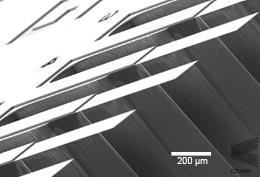 The new microcantilevers detect viruses binding to membrane proteins.Martin Hegner
The new microcantilevers detect viruses binding to membrane proteins.Martin HegnerPosted on 01/21/2009 12:06:22 AM PST by neverdem
Wobbly cantilevers 'feel' pathogens lock onto their targets.
 The new microcantilevers detect viruses binding to membrane proteins.Martin Hegner
The new microcantilevers detect viruses binding to membrane proteins.Martin HegnerViruses can now be detected directly in fluids, thanks to microscopic diving boards that vibrate when the pathogenic particles stick to cellular proteins. The findings could eventually lead to better blood tests and more sensitive ways of measuring whether new drugs are binding to their targets.
Microcantilevers — which look like springboards but are only 0.5 millimetres long and just 1 micrometer thick — wobble and bend in response to different forces. By measuring changes in the frequencies at which these tiny planks vibrate, researchers have, for example, turned them into super-sensitive virus-weighing scales.
But these biosensors have some limitations. Cell membrane proteins that bind to viruses are difficult to attach to the cantilevers and easily lose their activity when they're removed from cells. And because liquids dampen frequency changes, most measurements have been made in air, if not in a vacuum, rather than in physiological conditions.
Now nanobiotechnologist Martin Hegner, from the recently founded Centre for Research on Adaptive Nanostructures and Nanodevices (CRANN) in Dublin, and an international team of colleagues have circumvented both these problems, producing a cantilever array that detects finicky membrane proteins binding to viruses in fluids1.
The researchers have produced a "practical system", says physicist Jim Gimzewski of the University of California, Los Angeles. "I'm going to relook into my [biosensing] device in light of this paper."
To ensure that FhuA — an Escherichia coli membrane protein that is known to bind to the T5 virus — didn't lose its activity, Hegner and his colleagues reconstituted it in sheets of membrane-like vesicles, then sprayed the vesicles onto selected cantilevers in an array using inkjet technology, similar to that found in printers. They were also able to overcome the dampening effects of the fluid by measuring changes in high frequency vibrations, which are more sensitive to small changes in mass.
When the array was submerged in a T5-containing fluid, the researchers detected the virus binding to FhuA by measuring shifts in the vibrational frequency of the cantilevers. The study appears in Nature Nanotechnology.
"This is the first time anyone has been able to measure viruses in solution with a mechanical device," says Hegner.
Such biosensing systems, which are currently the size of a shoebox, provide promise as diagnostics that can detect viruses in blood samples, he says. And because cantilevers also bend when the coating proteins change shape, they could also conceivably be used to test whether drugs activate specific proteins.
But these uses are still "far away", cautions Hegner. "With respect to the manpower we have here, we still have a long way to go."
Despite currently heading up a team of only five people, Hegner is optimistic about the future of his work. In part, this might be linked to his recent move to CRANN, a Science Foundation of Ireland-funded nanotechnology institute that opened its doors in Dublin in 2008.
 Centre for Research on Adaptive Nanostructures and Nanodevices (CRANN).CRANN
Centre for Research on Adaptive Nanostructures and Nanodevices (CRANN).CRANNIt's a "nice and inspiring environment" that has "physics, chemistry and biology all in one building", says Hegner. "We really have an information exchange like I have not seen anywhere else in one building," he says.
Gimzewski, who visited recently, also liked the institute, but for different reasons. He was impressed by the ground-floor gallery, which holds exhibitions on subjects such as nanotechnology and fashion. "They really started out with an approach to make the public aware of nanotech," he says.
It is still too early to judge the calibre of research that is coming out of CRANN, he says, and the institute is much smaller than some other nanotechnology centres. But he still thinks it can make an impact.
"Being small, they can be nimble," he says. "They may do things that take the big guys by surprise."
Bleeding Hearts Revealed With New Scan
Green light for UK stem-cell trial - Stroke patients to be treated with tailor-made brain cells.
FReepmail me if you want on or off my health and science ping list.
As Napoleon Dynamite would say,"Flippin' Sweet!"
Cheers!
Like, *PING*, dudes.
micro and tech ping
Thanks for the ping. Not sure why the article claims there are such difficulties in binding the antibodies to the cantilevers. Folks have been binding the same antibodies to various magnetic and non-magnetic beads for years. Could be the difference between the silicon surface of the cantilevers and the (usually) polystyrene surface of the beads.

Beautiful micrograph of the cantilevers.
Time and again I am moved by the artistic quality you find in science and engineering photographs.
Disclaimer: Opinions posted on Free Republic are those of the individual posters and do not necessarily represent the opinion of Free Republic or its management. All materials posted herein are protected by copyright law and the exemption for fair use of copyrighted works.